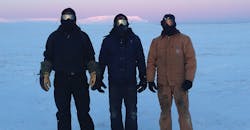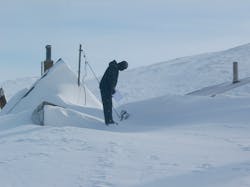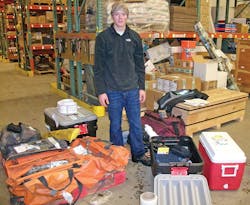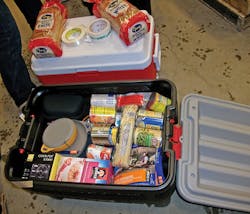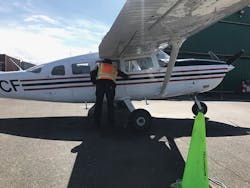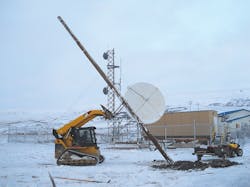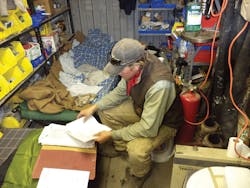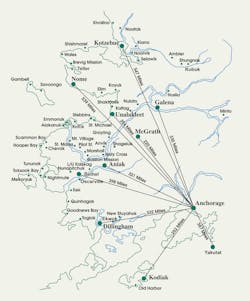Alaskan Linemen Brave Extreme Conditions to Work the Lines
During the Alaskan winter, the linemen for Alaska Village Electric Cooperative (AVEC) endure temperatures of 40 degrees below zero, see only a few hours of daylight each day, wrangle with ice-coated power lines and shovel several feet of snow. Compounding the challenge, many of the linemen work in two-person crews, or sometimes alone, in remote communities in the Alaskan bush.
The further north they travel, the linemen experience less daylight and colder temperatures during the wintertime. For example, Anchorage drops down to 5 hours and 45 minutes of daylight in the wintertime while Barrow’s residents don’t see the sun rise for several weeks.
At times, the sun will rise and set in less than an hour. To illuminate their surroundings, the linemen rely on headlamps and the lights on their snowmachines to cast light on their worksite.
The Northern Lights, a dazzling celestial light display during the Alaskan wintertime, also provides respite from the darkness. The only problem, however, is that they appear late at night or early in the morning, when the residents and the linemen are often fast asleep.
Avoiding Frostbite
Along with the Northern Lights, the Alaskan winters also produce extremely cold temperatures, strong winds and blizzards, which can sometimes drop several feet of snow over several days. Snowdrifts can cover up parts of the homes of AVEC’s members, limit access to the power plants and bury the ATVs in snow. As such, the linemen spend several hours shoveling snow to get their work done following a blizzard. Because ice often coats the power lines in the wintertime, the linemen use tools to beat the ice off the poles and lines. While heat can work temporarily, the power lines eventually cool down, allowing the ice to build back up.
To stay safe and warm in the cold temperatures, the linemen forgo cotton garments for multiple layers of clothing, arctic/extreme heavy-duty insulated outerwear and heavy-duty insulated boots. The boots can be cumbersome to wear while climbing poles, but they help to protect the linemen’s feet from frostbite, especially when they’re traveling on snowmachines. The linemen also can avoid frostbite by monitoring their exposure time and going inside at regular intervals to warm up. They must wear personal protective equipment such as hot gloves, safety glasses, hard hats, flame-retardant gear, and a face or arc shield.
Working in Remote Regions
For safety reasons, AVEC tries to assign linemen to work in two-person crews so they can look out for one another. At the beginning of the summer, AVEC hires 1000-hour apprentices. After the apprentices successfully complete a thorough orientation process, AVEC’s more senior linemen travel with the new hires. Because the work is hard and the linemen face challenging conditions, especially in the winter months, AVEC’s field workforce has a high turnover. Sometimes the new hires will only make one or two trips to AVEC’s remote communities and then they decide it’s not for them.
While some linemen don’t like living in a remote community far away from friends and family, others enjoy the adventure of it. For example, one of the AVEC linemen said he gets paid to go to and fly over beautiful areas, which he considers a major perk.
At times, the linemen end up working alone, but this is based mainly on the travel aspect of their jobs as well as emergencies that crop up, such as power outages or a lineman going on vacation. AVEC tries to limit the amount of time linemen work solo, but if they do, they aren’t required to climb poles energized. If for some reason new hires end up alone, they can do surface level work until help arrives. They can also work around the power plant shoveling snow, organizing parts or fixing broken equipment.
Packing for Adventure
Before they travel to one of the remote communities, the linemen must each pack large amounts of supplies. New linemen are provided with a cheat sheet detailing what to bring. For example, they pack a week’s worth of frozen food such as hamburgers, steaks and perishables inside large coolers. They then transport dry goods and canned fruits and vegetables in large travel totes. The linemen carry more frozen food and less canned food in the winter because the frigid temperatures can make the cans explode.
The food in the villages is extremely expensive, so the linemen shop at warehouse stores such as Costco to purchase a lot of bulk food. From experience, they have learned it’s best not to freeze mayonnaise, beans and ketchup. They’ve also learned to pack eggs carefully or purchase them from the village store. Also, bags of potato chips can explode while flying in a plane, and cheese in a can is considered hazmat. The linemen must avoid carrying glass or items that may explode.
Some linemen prepare large meals, such as stew or stir-fried dinners and separate them into containers, freeze them and take their homemade meals with them. It makes it easier for the linemen to have hearty meals at the end of a work day. Also, some of the linemen go fishing after work during fishing season to supplement their diet with fresh fish.
Flying to the Bush
Unlike in other parts of the country, traveling in bucket trucks on the open road is simply not an option in rural Alaska. To access the remote communities, the AVEC linemen must fly in small bush planes because of the lack of roads in Alaska. These planes are often noisy, small, fly low to the ground and can get pretty bumpy due to turbulence.
Every year, there are plane crashes in Alaska, and some of these have fatalities. Because their life is literally on the line every time they step on a bush plane, the linemen are allowed to choose with whom they feel comfortable flying. Over time, AVEC’s field employees get to know the “good” pilots.
The benefit of flying, versus driving, is that the planes fly so low that the linemen get to see the land, rivers and mountains up close. For example, it takes about eight hours to get from Anchorage to Kiana, located in northwest Alaska. To reach this destination, linemen must first board a jet to fly to a hub airport, like Kotzebue. Next, they must transfer all their gear into a small plane to fly farther north.
Traveling between communities can take many hours, and it often takes longer to fly north than south. To compensate them for their time, AVEC pays the linemen for eight hours for each of their travel days, regardless of the length of the flight.
Doing Old-School Line Work
When the linemen arrive in the remote communities, they can’t simply drive a bucket truck to the nearest worksite. The only bucket trucks are located in Bethel, and the rest of the linemen still use old-school methods to get the job done. For example, they rely upon block and tackle, pole pikes and come-alongs to help move and lift heavy equipment by hand. Often pole holes are dug with the venerable spoon and banjo.
In order to work in the smaller communities, the linemen must have ingenuity and find a way to “git ‘er done” with very limited resources. For example, the linemen can’t simply drive a few minutes to find a hardware store to purchase parts and equipment they need. They also usually don’t have cranes to help move heavy equipment such as fuel tanks, transformers or spools of wire.
As such, they must be innovative to quickly figure out a solution to problems that crop up, which is especially important in the cold winter months. It is a matter of life and death when it’s 40 degrees below zero and strong winds are blowing.
Living in the Villages
AVEC serves 58 communities with 48 prime-power plants that are all diesel, six standby power plants and interties to some communities. The cooperative also has the largest fleet of utility-grade wind turbines in Alaska, and these work in conjunction with the diesel power plants.
Not all of the remote villages, however, have access to running water or other basic amenities. Because the linemen can’t jump in a hot shower after a long work day, they clean themselves with baby wipes or camp showers that get set up in the power plant. Sometimes, they heat up the baby wipes in the microwave to provide some warmth when cleaning up.
Also, the linemen bring a lot of spare clothes so they don’t get too smelly or “stand up in a corner.” Most villages have showers and coin-operated washers and dryers in buildings called washeterias, but they are often expensive. To save money, linemen often use heated water in a 5-gallon bucket to have an old-fashioned bucket bath. Because the linemen carry large totes for their food, clothing and gear, they can fill these totes with water to act like a bathtub. To fill up these bathtubs, they can purchase water from the water plants in the villages or haul it from a river or lake.
The villages are typically located more than 600 miles from AVEC’s headquarters in Alaska and can require up to 10 hours of travel, so the linemen must stay several days in the villages. AVEC’s policy requires its field employees to stay out in remote, rural Alaska, called “the bush,” for a minimum of three weeks. Sometimes, the linemen can stay out in the villages for anywhere from five to eight weeks.
During this time, the linemen stay at the power plants in emergency living quarters (ELQs). These insulated Conex vans or shipping container vans have heat, lights, a microwave, small refrigerator, and a bunk bed. Some of the “fancier” ELQs contain sinks with buckets to collect used water, pots and pans, and plug-in two-burner stoves.
Even though the ELQs have heat, in a lot of villages the heat isn’t on 24/7, so the linemen must heat up the vans when they arrive. Some of the ELQs have incinolets, a form of stand-alone heated toilet that burns human waste. As soon as they’re ready, the linemen must flip a switch, and then the paper and the waste gets burned up into ashes, which can be disposed of in the landfill.
Many of the AVEC communities without running water and flush toilets use “honey buckets,” a 5-gallon plastic bucket with a toilet seat on top and a trash bag lining the bucket. After the bucket gets full of human waste, the honey bucket gets dumped in a huge container, which gets picked up by the honey bucket trucks or dumped out in a sewage lagoon.
Learning About the Culture
Each day working in the remote Alaskan villages may have its share of challenges, but also rare opportunities. For example, AVEC’s linemen have the opportunity to experience the beauty and culture of rural Alaska, including the culture of the communities and the native wildlife.
Each day brings something new for the linemen, and one day is different from the next. Unlike other field crews, which may be segmented in a particular department, AVEC’s linemen can learn about the entire operation of the utility. They’re able to help barges bring fuel to fill up tanks in the bulk fuel tank farms, learn about generators and engines that produce the power, and then get to see how it is distributed to the homes.
In particular, the linemen are able to go out into the communities and meet the members served by AVEC. When they fly into a village to restore power after an outage, they are able to personally experience the gratitude from the members. They also get the opportunity to discover the different cultures that compose the membership and see firsthand how they are able to harvest most of their food from the water and land to still live a mainly subsistence lifestyle.
As a result, AVEC’s linemen are able to explore all of Alaska — from the frozen poles to the Northern Lights to the wildlife crossing the snow-covered landscape. The work, especially in the winter, may test their strength and fortitude, but it gives them memories that they will cherish for years to come. ♦
Sam Lindquist is a distribution line superintendent with Alaska Village Electric Cooperative. He started off his career in the line trade as a lineman and now supervises other linemen for AVEC.
Sidebar: Linemen Power Rural Alaska
AVEC’s linemen often travel from the cooperative’s head-quarters in Anchorage, Alaska, to the hub communities, where they transfer to a smaller plane to fly out to the villages. The smallest villages served by AVEC have fewer than 100 residents, and the largest village, outside of Bethel and Yakutat, is Hooper Bay, with a population of 1188. This map shows where these communities are located within the state of Alaska.
Sidebar: Three Tips for Working in the Alaskan Bush
1. Wear mosquito repellent. The quantity of mosquitos buzzing around depends upon the location of the village, but the coastal areas get more wind, which reduces the number of mosquitos. Inside the interior of Alaska, however, mosquitos can be much more numerous and swarm in great quantities. In these areas, linemen wear mosquito spray with a lot of DEET or net clothing including a head net, mesh-net jacket and pants.
2. Watch out for the wildlife. When working in the remote communities, linemen can see bears, moose, caribou, musk ox, wolves, foxes, lynx and polar bears. They also can spot whales, walrus, seals and many types of fish. In some communities, they must be sure to keep an eye out for hungry, curious bears.
3. Plan ahead for logistics. Bad weather can delay flights that bring help or much-needed parts, so AVEC must order equipment such as power poles and transformers months in advance. That way, they can be put on a barge and shipped out to the villages for the linemen.
Check out the March 2018 issue for more articles, news and commentary.
About the Author
Sam Lindquist
Sam Lindquist is a distribution line superintendent with Alaska Village Electric Cooperative. He started off his career in the line trade as a lineman and now supervises other linemen for AVEC.
